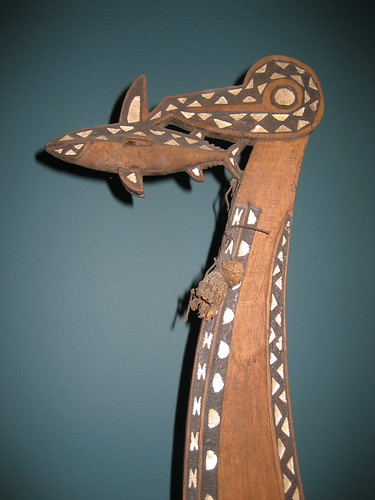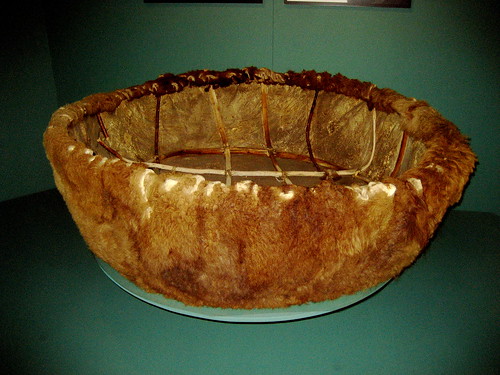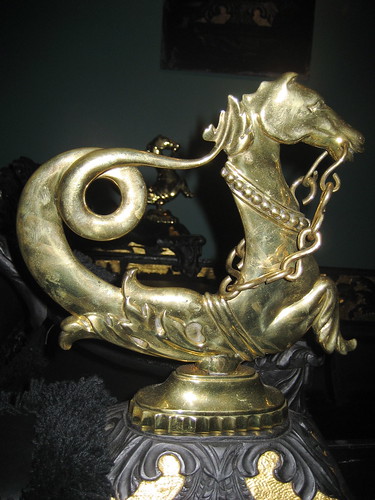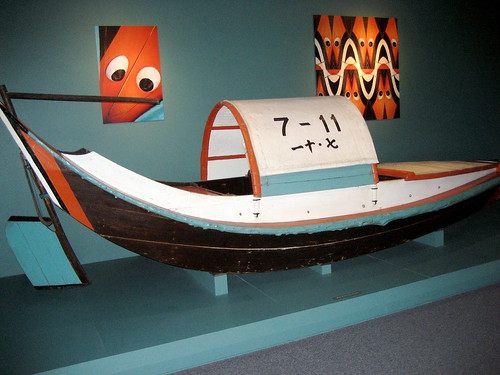Their Museum Educator, Armalita Holley, is passionate about education and puts a lot of thought and creativity into her homeschool days. This latest homeschool day was one of the best we've attended.
We started the day off with an "alphaboatical" scavenger hunt. The hunt took place in two of the exhibits, the Stationary Vogages exhibit and the International Small Craft Center.
We learned an enormous amount about boats just by doing this scavenger hunt. The three of us discovered that we are far more interested in learning about the various cultures than about actual boats. This meant that we were in heaven at the Stationary Vogages exhibit and lukewarm at the Small Craft Center.
Ben's favorite boat was the Solomon Island Ceremonial boat.

He was particularly taken with the carving on the bow.
Shira on the other hand fell in love with a boat of a completely different complexion. She loved the Native American, buffalo hide bull boat.

I found it interesting that the bull boats were originally boats used primarily by females, while boat Ben fell in love with was used exclusively by males.
I was drawn to the Taiwanese Tatara

Loved the feather decoration.

Ben and Shira are back on their "we have to go to Venice" chant after having a good look at the gondola on exhibit.


Aren't the colors on this Shanghai sampan just wonderful?

Orange speaks to my soul.
After we finished up with the scavenger hunt, a professor from Christopher Newport University taught a photography class.
He gave each child a disposable camera and sent them off to take photographs, while all the while remembering the following points:
- Take time to think before you click.
- Remember the "rule of thirds"
- When in doubt, get closer
- Don't let trees grow out of heads
- Don't clutter up the photographs
The museum is going to develop the photographs, critique them, bind them into a book and send them back to the kids. How neat is that?
This activity would have been even better if the children could have used their own digital cameras and emailed the photographs back to the museum. I realized on Friday that my children had never been exposed to an analogue camera. They've only used digital ones and are used to composing pictures on the screen and being able to look at what they've taken. It was quite an exercise in delayed gratification for them as they kept on wanting to look at the pics they had already taken.
We spent a lot of time in the Stationary Vogages Exhibit reading about the photographers' motivation. Ben and Shira are always drawn to artistic endeavors and reading about what the photographers thought about as they photographed the various boats helped bring the exhibit to life for the children. You can listen to podcastsof the photographers discussing their work.
Another fascinating exhibit was the
Archipelago: Portraits of Life in the Northwestern Hawaiian Islands
Archipelago: Portraits of Life in the Northwestern Hawaiian Islands features more than 60 photographs illustrating the spectacular diversity of the marine and terrestrial life in the national Oceanic and Atmospheric Administration's (NOAA) 14th marine sanctuary opens January 27 in the Daily Press Inc. Changing Gallery in the new USS Monitor Center. This exhibition hosts stunning images of rare plants and animals of the Northwestern Hawaiian Islands, made by legendary fine-art photographers and award-winning environmentalists David Littschwager and Susan Middleton. NOAA is The Mariners' Museum partner in the USS Monitor Center. NOAA's Monitor National Marine Sanctuary was the first marine sanctuary, designated in 1975.
The exhibit had a good blend of images, environmental information and back story. Ben and Shira make a beeline for it each time we visit the museum.
After we finished with the inside of the museum, we spent time in a paddle boat on Lake Maury and then took a leisurely stroll through their park. We felt like we were in the middle of the countryside. We left the museum all regenerated and relaxed. Normally my kids are all wired after we've visited museums, so this was a welcome change. The walk through nature did a lot to calm them down after the excitement of the scavenger hunt and the photography.
We've booked our spots for the rest of their homeschool programs. I was glad to hear that the programs are almost full already and the school year hasn't even started. It's always good to know that area homeschoolers are supporting museums that support our community.
Have a look at what we've signed up for. Doesn't it look like a lot of fun?
In the fall of 2008, the Education Department will be offering the Age of Exploration series for two age groups: 2nd through 4th graders and 5th through 8th graders. In this series, educators will introduce students to the economic and cultural life of Old World Europe, as well as discuss the reasons why Europeans went in search of new landmasses. Following this session, students will examine the people European explorers encountered; the nations who “discovered” the Americas and established eastern trade routes before the Golden Age of Exploration; and the technology and skills utilized to venture the high seas in search of new worlds.
Thursday, September 18, 1-4 P.M.: The European Race for Spice, Land, & Glory
Thursday, October 16, 1-4 P.M.: Encounters of a Strange Kind
Thursday, November 20, 1-4 P.M.: The Other Explorers
Thursday, December 18, 1-4 P.M.: Survival! Life @ Sea













No comments:
Post a Comment